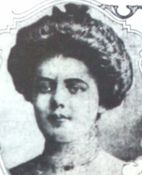 Do you know why a healthy person who makes other people sick may be called "Typhoid Mary"? There really was a Typhoid Mary. She was an apparently healthy person who caused more than ten documented epidemics of typhoid fever, at least three documented deaths, and probably many more cases that could not be confirmed (Ann Gastroenterol, 2013; 26(2): 132–134). Today we have enough evidence to know how to prevent these epidemics and how doctors could have kept her from infecting so many people.
Do you know why a healthy person who makes other people sick may be called "Typhoid Mary"? There really was a Typhoid Mary. She was an apparently healthy person who caused more than ten documented epidemics of typhoid fever, at least three documented deaths, and probably many more cases that could not be confirmed (Ann Gastroenterol, 2013; 26(2): 132–134). Today we have enough evidence to know how to prevent these epidemics and how doctors could have kept her from infecting so many people.
Mary Mallon was born in 1869 in Ireland and immigrated to the United States, at age 15, in 1884. She worked as a cook for many wealthy New York families and in several restaurants and caused several epidemics of typhoid fever where she worked. In 1900, at age 31, she disappeared after working for a family for only two weeks, when the entire family came down with typhoid fever. Typhoid fever causes horrible cramps, diarrhea, fever and even death. Later, an epidemic of typhoid fever was traced to a specific restaurant in New York and by the time the investigators arrived, they learned that Mary Mallon had worked there but had disappeared.
At age 32, she caused the same diarrhea, cramps and high fevers in another family in Manhattan. This time another employee for this family died of typhoid fever. Soon after that, she caused another bout of typhoid fever in a family of eight. At age 37 (1906), she caused an epidemic in a family in Oyster Bay, Long Island. The epidemics continued with every new employment and her disappearance soon afterwards.
Made Famous by a Medical Journal
The investigation of the episode in Oyster Bay was published in the Journal of the American Medical Association (JAMA, June 15, 1907;48(24):2030-2031). The family had hired an Irish woman about 40 years of age, tall, heavy, and single, who appeared to be in perfect health. She disappeared three weeks after the outbreak started and left no forwarding address. Her next appearance occurred in a Park Avenue penthouse where one of the infected people died. In 1908, another article in JAMA first called her "Typhoid Mary" and the name has stuck ever since (JAMA, 1908;50(19):1498-1502). This article was followed by an extensive investigation of 148 cases on how typhoid fever is spread by the unwashed hands of infected people touching food that other people eat (JAMA. 1908;51(3):194-200).
Mary Mallon refused health authorities' requests to supply urine or fecal samples to be cultured for the typhoid fever bacteria, Salmonella typhosa. Investigators found that, of the eight previous families that employed Mary Mallon, seven had suffered typhoid fever. Mary admitted that she did not wash her hands before preparing food.
First Quarantine 1907-1910
The New York City Health Department investigations led to her first arrest. She was forced to supply urine and stool samples which showed that she carried Salmonella typhosa. At that time, doctors knew that the reason people can carry typhoid fever bacteria and not be sick is that it grows in a person’s gall bladder. Some carriers can be cured by having their gall bladders removed, but Mary refused to have the surgery. As a result, she was kept in isolation in prison for three years and released in 1910, after agreeing to stop working as a cook and to take precautions to protect others from infection. She was given a job cleaning clothes. However, she hated that job, so she changed her name to Mary Brown and resumed her work as a cook. Over the next five years, the epidemics continued, but she would disappear before she could be caught and reappear later in another restaurant under another assumed name.
Second Quarantine 1915-1938
She had caused at least ten different proven outbreaks of typhoid fever and at least three deaths before she was caught again and put in isolation a second time. Because she was a habitual offender who refused to be rehabilitated, she remained in supervised and controlled settings for the rest of her life, working as a technician in the prison’s laboratory. At age 63, she was paralyzed by a stroke and at age 69, she died of pneumonia, 31 years after causing her first epidemic. At her autopsy, her gall bladder was found to be teeming with live typhoid bacteria and the authorities wisely cremated her body.
Today Doctors Can Cure Typhoid Carriers
Typhoid Mary carried the typhoid fever germ in her gall bladder even though she, herself, was not sick. The germs traveled from her gall bladder down the common bile duct, into the intestines and out in her stool to her hands. Since her hands were full of the germ that causes typhoid fever, everything she touched could then be teeming with that germ. When a person ate that food, the germ would enter the intestinal tract where it could cause high fever, chills, muscular aches, diarrhea and sometimes death.
If it happened today, she would not have been placed in quarantine and she could be cured by taking antibiotics or by having her gall bladder removed.
If You Have Had Typhoid Fever, You Must Be Checked
People who carry typhoid fever germs in their gall bladders are at increased risk for developing cancers, even though they may have no symptoms at all (Lancet, January 8, 1994 343:83-84). All people who have had typhoid fever and appear to have recovered should have stool cultures done to see if they still carry the typhoid fever germ. If they do, they may need to take antibiotics or have their gall bladders removed. What a difference a century makes.
September 23, 1869 – November 11, 1938


